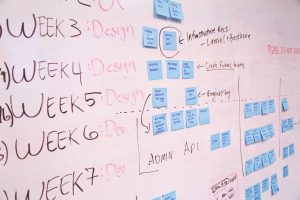Embracing the Shift in Construction: From Waterfall to Agile Methodologies
Co-authored by Lucas Marshall and Jason Braun, this article details the nuances of productivity in varying industries, with a sharp focus on the dynamism in the construction sector. A sector that according to the Becker Friedman Institute for Economics at the University of Chicago, is both “strange and awful” proportionately, a view representing raw BEA data.
The Challenge of Measuring Productivity
In any industry, measuring productivity is a complex task. No uniform yardstick can capture the diversity and peculiarity of each sector. Particularly in the construction realm, the challenge of productivity measurement becomes even more arduous. The Becker Friedman Institute for Economics categorizes the construction industry as both “strange and awful,” reflecting perplexing BEA data. This characterization underscores the industry’s difficulties, with its metrics often diverging from traditional norms and expectations.
Transforming Construction Methods: From Waterfall to Agile
The construction sector, despite its complexities, is undergoing a profound transformation, shifting from conventional waterfall methodologies to agile architecture. This shift marks a new era in construction, providing greater project flexibility, efficiency, and adaptability.
Waterfall methods, defined by their linear and rigid project stages, are gradually being swapped for the more flexible, iterative, and responsive agile techniques. Agile architecture emphasizes collaboration and customer service, offering a robust response to the inherent unpredictability and changing demands of construction projects.
The Role of Strategies and Tools in Agile Transformation
This agile transformation is not devoid of challenges. To ensure a smooth transition, companies need to adopt innovative strategies and leverage advanced tools. Tools like those offered by Qamodo’s project management suite can be instrumental in delivering projects successfully.
These tools enable teams to manage tasks and goals effectively, execute projects using Gantt and Kanban features, and even handle client relations effortlessly. The ability to carry out all these functions within a single platform makes this suite an indispensible tool to enhance productivity and facilitate organizational transition from waterfall to agile methodologies.
Conclusion
The construction industry is entering a new era, characterized by an innovative approach to project management. By moving from waterfall to agile methodologies, companies can enhance their project efficiency, adaptability, and overall productivity. The shift, although challenging, can be managed efficiently with the assistance of right strategies and advanced tools, like those provided by Qamodo’s project management platform, offering a suite of integrated functions for managing tasks and goals, planning with Gantt & Kanban, and maintaining client relations.
With Qamodo’s project management tools at their disposal, construction companies can seamlessly transition into this new era, ensuring their projects are executed efficiently, effectively, and in line with the evolving market trends and client needs.








